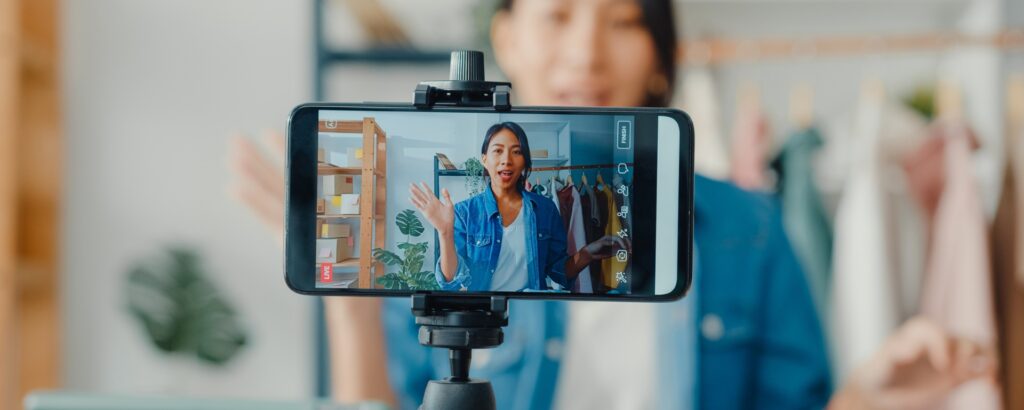Influencer marketing: fashion trend or necessity?
Share this article
Tags
Categories

Influencer marketing: what it is, what it can do and why it is also interesting for you
It is no longer so easy for store operators to create a lasting effect on their target groups with traditional advertising. In times of banner blindness, advertising fatigue and widespread ad blockers, more and more brands are turning away from targeted advertising and turning to influencer marketing for companies.
The topic is also increasingly causing a stir in e-commerce. The Influencer Marketing Benchmark Report 2021 from Influencer Marketing Hub comes to meaningful results in an international survey:
- Spending on influencer marketing amounted to almost 14 billion US dollars in 2021. More than twice as high as two years previously.
- 90 % of survey participants consider influencer marketing to be an effective form of marketing.
- 75 % of them intended to allocate a budget for influencer marketing in 2021.
With this in mind, it comes as no surprise that both newcomers and professionals in the industry are increasingly examining this phenomenon for their own purposes.
Why (almost) everyone is talking about influencer marketing for companies
What is influencer marketing in general and what are the goals and benefits specifically for companies in online retail?
In short, influencer marketing is a new twist on the old technique of using celebrities as brand ambassadors. However, this is done in a way that adapts to today's world and modern consumers.

These influencers regularly publish their own content (audio, video, text or images) tailored to their community on specific topics. The aim of the collaboration is to bring the brand message to the public and ultimately influence the purchasing behavior of users in the interests of the company.
What types of influencers are there?
Brand strategist Karsten Kilian defines influencers as "people with reputation, influence and reach (...)". In contrast to classic testimonials, however, influencers are usually not established celebrities who are known from "radio and television". Rather, they are social media stars who are perceived as authentic and credible by their respective communities. Their opinions carry weight.
Influencers are often differentiated according to their follower numbers and engagement rate (the ratio of reach to initiated interactions):
- Macro influencers:inside with more than 100,000 followers and an engagement rate of between 5 and 25 %. Recruiting them for your own brand communication is usually expensive. However, macro-influencers are ideal for product launches that appeal to a wide audience and to increase brand awareness.
- Micro-influencers with 10,000 to 100,000 followers and an engagement rate between 25 and 50 % are often highly engaged content creators who can be used effectively in sales promotion because they convey niche topics with great credibility.
- Nano-influencers:inside with up to 10,000 followers and often very high engagement rates are ideal for brand campaigns in highly specialized niche and special interest markets. The costs for nano influencers are low, but they can be unbeatable in terms of their impact on the relevant market segment.
Sometimes a distinction is also made between mega-influencers (more than one million followers) and giga-influencers (more than 10 million followers). These are dimensions that have no profitable relevance for the vast majority of online stores, as they are associated with correspondingly high costs. Ultimately, it's always about finding the right influencers who convincingly represent your brand essence.
What forms of influencer marketing are there?
You shouldn't think of influencer marketing as unstructured chit-chat. Rather, there are specific formats for specific purposes. Here are a few of the most important ones:
- HaulsThis can be aboutYouTube-videos or Instagram-stories in which influencers discuss their purchases. They go into detail about the individual products, their first impressions or the shopping experience as a whole. A haul usually consists of several products from one retailer, a certain group of stores or at least a category in which the products are all related to each other.
- LookBooksIn earlier times, a LookBook would have been called a fashion catalog. In influencer marketing, LookBooks are digital and are used on the website, in the mobile app, on social media and in email marketing. The purpose of a LookBook is to present the latest collection of a brand or designer in a positive, marketable light.
- UnboxingThese are videos in which influencers unpack and try out a product. The element of surprise associated with unboxing creates a certain storytelling tension.
- TutorialsHow-to video tutorials that explain how a product works or how to use it to carry out a DIY project, for example.
- ChallengesBranded hashtag challenges: All participants spontaneously invite other users to take on a challenge, sometimes more, sometimes less demanding, that is somehow related to a specific product. It is the format par excellence for creating a continuous and spontaneous connection, especially with a younger audience. Once posted, a snowball effect quickly develops. This is how reach is created through user-generated content.
Which platforms are suitable for effective influencer marketing?
There are two types of platforms that are relevant in influencer marketing. Firstly, those that influencers use to reach their target groups. The top dogs include:
- YouTube
- TikTok
- Snapchat
- Twitch
On the other hand, there are software solutions that bring companies and influencers together. With a corresponding database and targeted search options, these platforms make influencer marketing much easier. For example:
- Buzzbird: is one of the leading providers in the DACH region. As a full-service agency, it not only finds influencers, but also plans, executes and measures campaigns.
- HelloInfluencer: also concentrates on German-speaking countries and does not use agency services, which is why it is also suitable for projects with a small budget.
- Storyclashfrom Austria, offers the special feature of searching influencer content specifically for keywords, for example. This is helpful in finding the right fit for your brand.
What are the risks of influencer marketing?
On the one hand, the legal situation regarding influencer marketing is still not always clear. For example, when it comes to the question of whether what is posted by influencers is advertising and must be labeled as such (not always, according to a ruling by the Federal Court of Justice in September 2021).
Perhaps the greatest danger, however, is that influencer marketing can tarnish or, in the worst case, destroy a company's own brand image. If there are suddenly glaring problems with the credibility of influencers, the collaboration can quickly turn into a disaster for a company. A recent example of this is the controversy surrounding the previously very successful YouTuber Fynn Kliemann in May 2022.
Success factors in influencer marketing: a few tips at the end
As you can see, using influencers is not always easy. Online retailers have a lot to consider to ensure that their influencer marketing is successful. Here are a few basics you should keep in mind.
- Be aware of your own brand image
In principle, influencer marketing works with any brand. But it makes a difference whether you're in beauty products or motor oil. In the latter case, you will probably need to work more on your brand image in advance. Fashion and beauty, consumer electronics and health and wellness, on the other hand, are natural candidates for influencer marketing.
- Check the authenticity of all cooperation partners and influencers
Authenticity and credibility are the most important currency in influencer marketing. Finding the right partners is therefore often the biggest challenge. Even if you work with influencers who don't have a large fan base: You won't recover from a shitstorm on social media anytime soon.
- Don't be afraid of small followers:inside numbers
Relevance beats reach, especially for stores that cover niche product types. It doesn't always have to be the mega or giga influencers. If you reach the target group with the right tone and clever content, that's the main prize. And a small audience is often characterized by particular loyalty.
- Give influencers creative freedom
Influencers resonate with their audience for a reason. So give them as much freedom as possible. Too many rules and regulations can disrupt the creative vibes. This would affect follower engagement.
- Measure, measure and then measure again
One of the great advantages of influencer marketing is that (as with online marketing as a whole) success or failure can be measured. So use the appropriate tools to determine what works, what has achieved specific goals within a defined time frame, and what has not, in order to adjust your strategy if necessary.
Further contributions
No contributions found.
